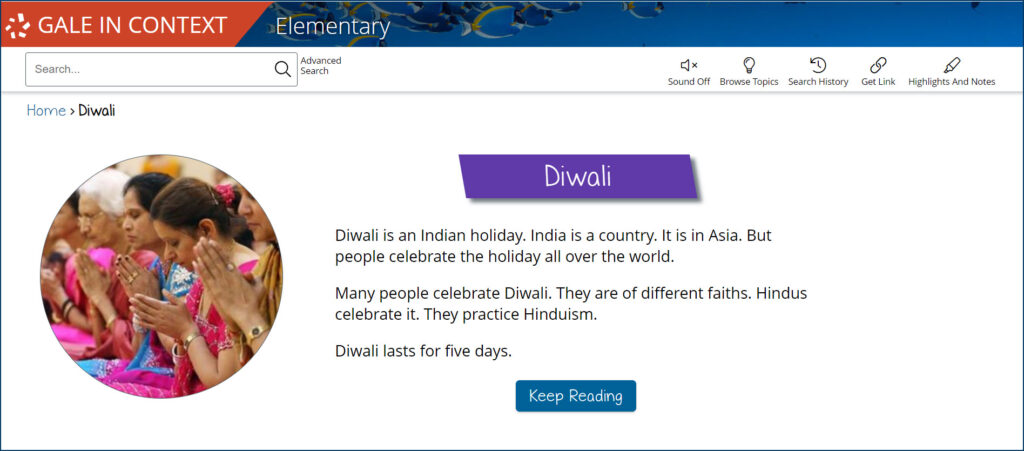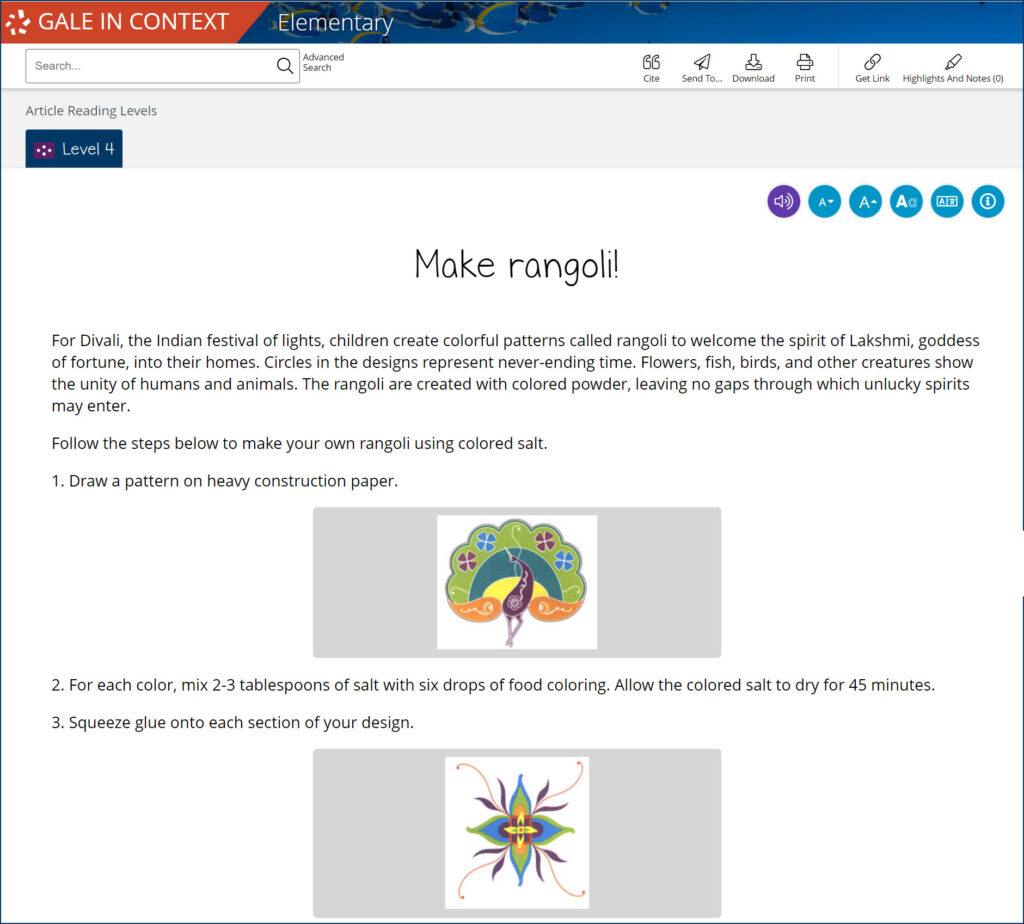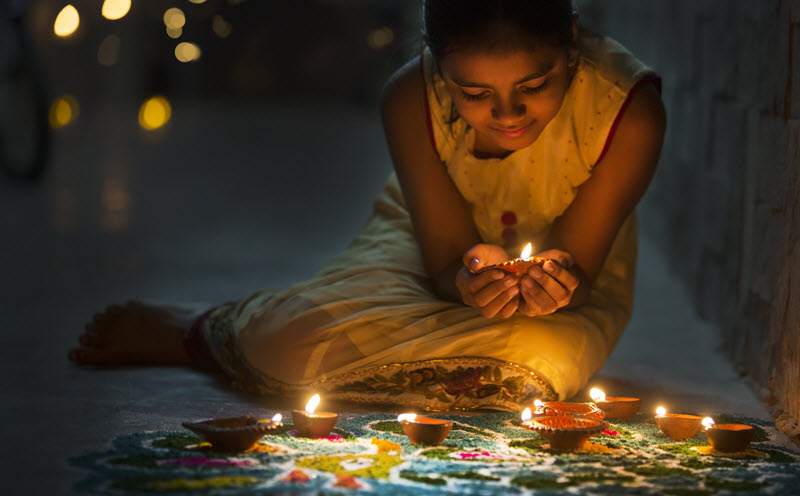| By Gale Staff |
Predominantly a Hindu festival practiced in India, Diwali—also known as the Festival of Lights—is celebrated by a variety of people from different faiths all over the world. You may even have students in your class who observe the holiday with their families.
Still used in modern India to establish important religious dates, the Hindu calendar consists of 12 months corresponding to 12 full cycles of the moon. Kartika, the eighth cycle, falls between the months of October and November and is considered the Hindu deity Krishna’s favorite month, making it one of the holiest times in India. On the fifteenth day of that month, Hindi people celebrate Diwali, commonly pronounced “dih-wah-lee” or “dih-vah-lee” depending on the spelling. In 2023, Diwali is observed on Monday, November 13.
Gale In Context: Elementary has a dedicated portal for young students learning about Diwali. While the fall semester offers teachers a wide variety of holidays to engage students, Diwali’s festive nature lends itself well to young learners. The holiday’s colorful decorations and associated legends offer interesting entry points for elementary learners while the opportunity to introduce a holiday with Eastern roots helps them develop new perspectives and an appreciation for cultures originating outside of North America.

Leverage Elementary to learn about Diwali’s fascinating stories and unique customs. While exploring the portal’s images, articles, and related resources, you’ll find plenty of content to help students identify cultural similarities and differences. Encouraging them to recognize how certain values such as family and food transcend geography and religion and create common ground across cultures.
Showcase the Legends of Diwali
While the exact legend behind Diwali varies throughout India, most versions feature a beloved deity or leader defeating a demon. One of the main stories is that of King Rama’s return. After his stepmother banished him to the forest for 14 years, Rama, the true heir to the throne, defeated a demon and reclaimed his rightful place. His people lit lamps outside their homes to help him find his way back and to honor his victory over evil.
Jainism, another Indian religion that acknowledges Diwali, teaches a belief in reincarnation similar to Hinduism and Buddhism. The Jains celebrate Diwali to memorialize when the great hero Mahavira broke the cycle of reincarnation and achieved nirvana.
In yet another twist on the legend behind Diwali, the Sikhs honor a 17th-century guru known as Guru Hargobind who cleverly brought 52 fellow prisoners along with him when he was freed from prison.
Alongside the mythical tales of Mahavira and Guru Hardobind, there are even more fascinating characters associated with Diwali. With Gale In Context: Elementary, your students can discover captivating adventures, learn new vocabulary, and appreciate different religious beliefs and histories.
Discover How Families Celebrate Diwali
All told, more than a billion people recognize Diwali each Fall. Diwali customs can have some variation of course, but certain aspects are shared among most who celebrate it. For example, families in India place lanterns outside to celebrate light in the darkness or good over evil. There are fireworks, large family meals, new outfits, and the exchange of gifts.
Encourage your students to explore more articles within Gale In Context: Elementary’s Diwali portal. What connections can they find between Diwali customs and some of their own favorite holidays? Encourage them to think critically about why these similarities exist throughout the world.
Do you have any students who already celebrate Diwali with their families? Look for opportunities to get these students more involved in lessons by asking them if they would like to elaborate on certain aspects of the holiday or help guide fellow students in a related activity.
Activity Idea: Diwali is a five-day celebration, and each day has its own themes and practices. Integrate this same schedule during the November 13-17 school week:
- Day One, Dhanteras: The first day of Diwali is often spent cleaning and getting homes ready for visiting guests. Ask students to take some time to clean out their desks and get reorganized.
- Day Two, Choti Diwali: Have students make their own rangoli art to decorate the classroom.
- Day Three, Diwali: This is the main day of the festival. Gather supplies for students to make their own diyas (lights) and read Diwali legends together.
- Day Four, Vishwakarma: As a class, try some traditional Indian foods. Samosas, fried dumplings (gulab jamun), and sweet rice pudding (kheer) are all popular choices. If you have a culinary space in your school, you could try making some recipes as a class.
- Day Five, Bhai Dooj: This day is a time to reflect with family and celebrate sibling bonds. Have students share what they love most about their own family members.

Integrate Teacher-Dedicated Tools
Gale In Context: Elementary is a student-friendly database ideal for developing early research skills. But teachers could benefit from a portal all their own. Gale In Context: For Educators, a teacher-dedicated database pairs seamlessly with Gale In Context: Elementary and other Gale resources to offer your district a comprehensive teaching and learning experience.
Gale In Context: For Educators lightens your daily responsibilities and streamlines your professional goals. You can access ready-made lesson plan templates and customizable activities, all vetted through state and national curricular guidance. Rather than starting from scratch or combing through past materials, utilize Gale’s user-friendly navigation tools and organizational structure to identify exactly what you need. Plus, you can effortlessly upload content to your school’s learning management system and customize articles with your own notes and directions.
In addition to lesson planning shortcuts, teachers can leverage professional development resources and collaboration tools. Gale In Context: For Educators helps you connect with other teachers and stay organized. We know your time is precious. With this resource, you’ll have more time to provide individualized instruction for your students, whether you’re teaching the legend of Diwali or innovations in engineering.
Holidays like Diwali provide a fun, engaging lens for learning about different cultures and traditions around the globe. These lessons inspire curiosity and empathy in young learners, connecting them with people and values they otherwise might never discover on their own.
If your school district is not a current Gale subscriber, contact a local representative to discuss the next steps. You can access a trial period for Gale In Context: Elementary and Gale In Context: For Educators.

